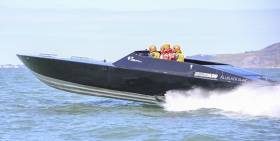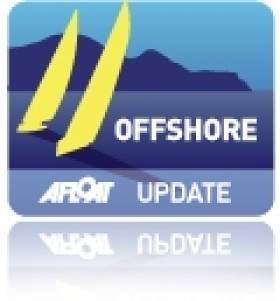Displaying items by tag: Round Ireland RIB record
Round Ireland Powerboat Record Bid This Weekend
A bid to break the 2009 Round Ireland powerboat record will be made this weekend. Venture Cup entrant John Ryan and his Team Hibernia crew will make an attempt at the record on Sunday. Starting in Kinsale on the South Coast, Ryan and his four man crew will need to be back in the Munster harbour within 19 hours if they are to break the seven–year–old record set in a time of 18 hours 38 minutes and 50 seconds.
Hibernia Racing's 100 mph –ALLBLACK SL44 entry is built for marathon racing and has a range of 500–miles, making it possible for the circumnavigation to be made with just one refuel stop. The sleek aluminium built craft was testing in Cork Harbour a month ago and was powering around Dublin Bay in the past fortnight as preparation for the now cancelled Venture Cup.
The 2009 record holder Philip Fitzgibbon will be part of this weekend's attempt and joins the four–man crew as navigator. Sean McNamara and Denis Dillon complete the line–up.
'We''re going clockwise from Kinsale. I'm keen to get the Atlantic out of the way first', Ryan told Afloat.ie this afternoon.
Fitzgibbon and Mike Shanahan reclaimed their Round Ireland Powerboat Record powering over the Kinsale finish line to become the first team to set a sub 19–hour time for the circumavigation of Ireland in October 2009. The record was set in a 7.5 metre RIB powered by a 250hp engine.
Track Round Ireland Speed Sailing Record Bid Here!
#roundirelandrecord – Damian Foxall's Round Ireland speed sailing record bid due to start Friday, March 22nd has not got off to the most auspicious start. Battered by strong winds and big waves in the Irish Sea the giant tri under skipper Sidney Gavignet has been reduced to bare poles on its 1000km delivery trip from Lorient, France. The crew is 'on stand-by' and currently looking for shelter on the Welsh coast (1500 Friday) before attempting the Dublin Bay startline. There are unconfirmed reports now that the attempt will be postponed until tomorrow (Saturday). Track the progress of the giant MOD 70 trimaran via the Yellow GPS tracker (above) on Afloat.ie. Remember – once they cross the Dun Laoghaire line 44 hours is the record time to beat! Read WM Nixon's review of all previous Round Ireland speed records dating back to 1899 here!
The Sultanate of Oman's MOD70 flagship Musandam-Oman Sail is due to kick off a busy racing season with this Round Ireland Record attempt but it is only one part of the crew's busy season. French skipper Sidney Gavignet returns to lead the 6-man crew made up of Omani sailors and well-known international pros (including our own Damian Foxall) for a season that will also include the Route des Princes and the Rolex Fastnet Race in August.
Gavignet's new look crew on Oman's flagship Multi One Design 70 Musandam-Oman Sail have brought with them new expectations for the 2013 season as their preparations start in earnest this week with an attempt on the long-standing Round Ireland record.
As part of an intensive three week training programme, the Oman Sail crew, featuring three new faces from last season, will make a bid on the 20 year-old record as a practice run for the team's busy racing schedule later this summer.
The 700-mile sprint through the lumpy Irish Seas and the Atlantic Ocean is sure to be a baptism of fire for one of the new crew, Omani sailor Ahmed Al Maamari who only recently stepped aboard the MOD70.






























































